News
Surveys Show COVID-19 Stresses on Cloud Costs, Security
The COVID-19 pandemic may be lessening in the U.S., but its effects on enterprise cloud computing costs and security concerns may well linger for a while, new surveys suggest.
On the cloud computing costs front, a survey conducted by Anodot, "2021 State of Cloud Costs Report," focuses on "misspend" and lost revenue, much of which was caused by the remote work surge. It reported that 55 percent of respondents were surprised by cloud costs or experienced sudden cost spikes, many of which weren't discovered until days, weeks or even months later.
"The pandemic upended business for many or at the very least cast a grim shade of uncertainty, so, as many took to working from home, they also were commissioned with cutting waste," said Anodot, a specialist in AD-driven business monitoring. "Among the biggest sources of misspend in 2020 -- cloud services. And remote work may have actually spurred the problem, as organizations migrate more applications to the cloud to support these workers."
This spring, the company surveyed more than 100 senior IT, finance and operations leaders to discern how cloud usage was affected by recent events, including the pandemic.
"For most organizations, cloud services and Software-as-a-Service represent a large and fast-growing share of their budgets," the company said. "Cloud computing is projected to make up 14 percent of enterprise IT spending worldwide in 2024 -- up from 9 percent in 2020, according to a recent report by research firm Gartner. This will continue a trend. The firm says that worldwide spending on public cloud services will grow 18 percent this year alone to a total of $304.9 billion, up from $257.5 billion in 2020."
Many professionals didn't just see occasional surges in cloud usage. 72 percent say their cloud bills increased 4-fold to 11-fold over a 6-month period last year.
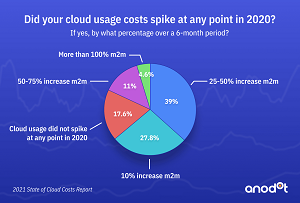 [Click on image for larger view.] Did Your Cloud Usage Costs Spike at Any Point in 2020? (source: Anodot).
[Click on image for larger view.] Did Your Cloud Usage Costs Spike at Any Point in 2020? (source: Anodot).
64 percent of those surveyed say they don't find cloud cost spikes until days, weeks, or even months later. One in five of those companies spend more than $2 million annually on cloud services, and the financial impact can easily amount to hundreds of thousands in lost revenue.
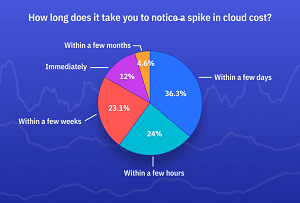 [Click on image for larger view.] How Long Does It Take You to Notice a Spike in Cloud Cost? (source: Anodot).
[Click on image for larger view.] How Long Does It Take You to Notice a Spike in Cloud Cost? (source: Anodot).
Other highlights of the report include:
-
52.8 percent of respondents said their average annual spend on cloud services was between $50,000 and $500,000
-
53.7 percent said they had been surprised by cloud costs or had an incident related to cloud costs
-
50.9 percent said they are able to remediate cost usage and cost issues in real time
-
70.4 percent said cloud costs are a consideration in day-to-day work
-
55.6 percent said their organization creates a cloud usage budget per developer or per team
-
49.1 percent said operations pros are the first to notice a spike, followed by engineering (34.2 percent) and finance (16.7 percent)
On the cloud security front, Devo Technology assessed the current state and pace of change with regards to enterprise cloud transformation initiatives and the ramifications on teams running a Security Operations Center (SOC). Its findings are revealed in a report titled "Beyond Cloud Adoption: How to Embrace the Cloud for Security and Business Benefits," conducted by the Enterprise Strategy Group (ESG).
It polled 500 IT and security personnel in the "SOC chain of command" at enterprise-class (i.e., more than 1,000 employees) organizations in North America and Western Europe in January 2021.
The survey revealed found that COVID-19 "accelerated business transformation far past the cloud tipping point and uncovered severe and far-reaching implications for security teams."
One of those business transformations was the pandemic-driven and well-documented shift to remote work. "With such a massive and rapid shift, the current infrastructure of technology and people are not well aligned with these new realities," the report said. "Respondents cited significant issues of complexity and overload -- most notably, 80 percent citing as much as 40 percent more security data on which they need to analyze and act. The staffing costs are also high with 41 percent citing challenges of increased workload, and 35 percent identifying a security skill mismatch -- all resulting in higher exposure. In 60 percent of organizations, they have seen an increase in threat and attack complexity, and in more than 60 percent, it has exposed weaknesses in legacy security toolsets."
Highlights of the report include:
-
Respondents who use a SaaS SIEM (security information and event management) have noted numerous benefits. 91 percent say that they've achieved greater SIEM scalability, 87 percent report greater visibility, and 85 percent see greater uptime/availability. While only 9 percent of the survey population currently uses a SaaS SIEM, another 22 percent plan on switching from an on-premises SIEM to a SaaS-delivered solution.
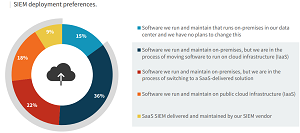 [Click on image for larger view.] SIEM Deployment Preferences (source: Devo Technology).
[Click on image for larger view.] SIEM Deployment Preferences (source: Devo Technology).
-
68 percent believe that cloud computing has made "IT and security operations more complex."
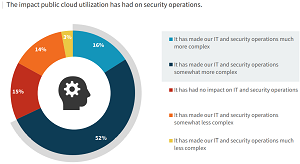 [Click on image for larger view.] The Impact Public Cloud Utilization Has Had on Security Operations (source: Devo Technology).
[Click on image for larger view.] The Impact Public Cloud Utilization Has Had on Security Operations (source: Devo Technology).
-
80 percent of survey respondents agree that cloud computing has led to an increase in the amount of security data to analyze.
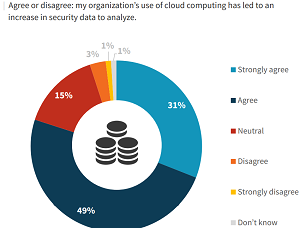 [Click on image for larger view.] Agree or Disagree (source: Devo Technology).
[Click on image for larger view.] Agree or Disagree (source: Devo Technology).
-
Only one-third of organizations claim they are very confident that their organization's tools provide adequate security visibility into cloud-resident workloads.
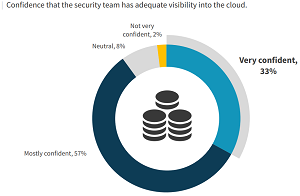 [Click on image for larger view.] Confidence that the Security Team Has Adequate Visibility into the Cloud (source: Devo Technology).
[Click on image for larger view.] Confidence that the Security Team Has Adequate Visibility into the Cloud (source: Devo Technology).
Many more details of the report sponsored by Devo Technology, a cloud-native logging and security analytics specialist, can be found here.
About the Author
David Ramel is an editor and writer at Converge 360.